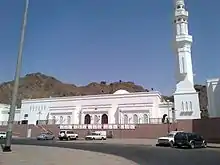| Part of a series on Islamism |
|---|
|
|
| Part of a series on:
Salafi movement |
|---|
 |
|
|
Sahwa movement (Awakening movement) or Al-Sahwa Al-Islamiyya (Islamic awakening) was a movement in Saudi Arabia from 1960–1980 which advocated for incorporating more reliance on Wahhabi principles into Saudi society. The most noticeable effects of the movement were significant restrictions on women's rights, religious freedom, and personal liberties.[1][2] The movement's core doctrines were shaped by the fundamentalist tenets of Qutbism; such as theological denunciations of democracy and the belief that contemporary governments of the Muslim World have apostatised.[3]
Sahwa is a Saudi term that refers to all political Islam movements whose major umbrella is the Qutbi Muslim Brotherhood. Saudi Arabia is almost unique in giving the ulema (the body of Islamic religious leaders and jurists) a direct role in government.[4] The Sahwa-inspired ulema have been a key influence in major government decisions, for example the imposition of the oil embargo in 1973 and the invitation to foreign troops to Saudi Arabia in 1990.[5] In addition, they have had a major role in the judicial and education systems[6] and a monopoly of authority in the sphere of religious and social morals.[7]
The movement came to an end after the appointment of Crown Prince Mohammed bin Salman in 2017 who declared a return to “moderate Islam”,[8][9] but the Sahwa’s ideas and activists, though persecuted,[10] continue to be popular.[11]
Safar al-Hawali, Muhamad Qutb, Muhammad Surur and Salman al-Ouda are the main scholarly representatives of this movement. The Sahwa movement's calls to forcibly expel American troops from the Islamic World would inspire numerous pan-Islamist militant networks; most noticeably Al-Qaeda. Osama Bin Laden's anti-Americanism was shaped by the major intellectual figures of the Sahwa; who popularised Sayyid Qutb's works and ideas. Saudi suppression of Sahwa trends would lead Bin Laden to excommunicate the government and publicly call to overthrow the Saudi authorities during the early 1990s.[12][13][14]
Origin
Muslim Brotherhood members arrived in Saudi Arabia in the 1950s and 1960s seeking refuge from persecution by the Egyptian socialist regime. They always had disputes with Wahhabism. Wahhabism and the Brotherhood influenced each other and this cross-pollination resulted in the birth of a hybrid movement of religious-political dissent known as the Sahwa movement. It reached a peak in the 1990s before being repressed by the Saudi establishment.[15]
Since the Iranian Revolution, however, the idea of clerical rule has become more attractive within Sunni circles. For example, in the Palestinian territories during the early 1980s some Muslim Brothers were unable to find Sunni justifications for active resistance to the Israelis and, therefore, turned to Khomeinist teachings.[16]
Activities
Sahwa members write public petitions and circulate sermons on audio cassettes. Sahwa leaders demand a bigger role for clergy in governing, curbs on the royal family's privileges, greater transparency for public funds, and a more Islamically conservative society as a defense against Western cultural influences.[15]
Views
They oppose the presence of US troops on the Muslim land. In 1991, al-Hawali delivered a sermon stating: "What is happening in the Gulf is part of a larger Western design to dominate the whole Arab and Muslim world."[17]
See also
References
- ↑ "Obstacles to Equality for Saudi Women". Middle East Institute. Retrieved 10 July 2022.
- ↑ "SAUDI ARABIA, Human Rights Developments". www.hrw.org. Retrieved 10 July 2022.
- ↑ Wehrey, Frederic (2017). Beyond Sunni and Shia: The Roots of Sectarianism in a Changing Middle East. 198 Madison Avenue, New York, NY 10016: Oxford University Press. pp. 42–45. ISBN 9780190876050.
{{cite book}}: CS1 maint: location (link) - ↑ Goldstein, Natalie (2010). Religion and the State. Facts On File. p. 118. ISBN 978-0-8160-8090-8.
- ↑ Obaid, Nawaf E. (September 1999). "The Power of Saudi Arabia's Islamic Leaders". Middle East Quarterly. VI (3): 51–58.
- ↑ Farsy, Fouad (1992). Modernity and tradition: the Saudi equation. Knight Communications. p. 29. ISBN 978-1-874132-03-5.
- ↑ Ron Eduard Hassner (2009). War on sacred grounds. Ithaca : Cornell University Press. p. 143. ISBN 978-0-8014-4806-5.
- ↑ "I will return Saudi Arabia to moderate Islam, says crown prince". the Guardian. 24 October 2017. Retrieved 11 October 2021.
- ↑ "Saudi Arabia's Islamic Awakening Could be Facing Its Demise". Fanack.com. 6 November 2018. Retrieved 10 July 2022.
- ↑ "Saudi Arabia 'arrests clerics in crackdown on dissent'". BBC News. 13 September 2017. Retrieved 10 July 2022.
- ↑ Ibrahim, Arwa. "What is Sahwa, the Awakening movement under pressure in Saudi?". www.aljazeera.com. Retrieved 10 July 2022.
- ↑ Heurman, Rinse (2020). Salafism and the Political: A Case Study of the Egyptian Hizb al-Nour (PDF) (Thesis). Radboud University Nijmegen. Retrieved 20 September 2021.
- ↑ Ismail, Evin (2022). "8: Between Qutb and ISIS: The Sahwa". The Antisemitic Origins of Islamist Violence: A Study of the Muslim Brotherhood and the Islamic State. Uppsala University, SE-75126 Uppsala, Sweden: Uppsala University. pp. 165–167. ISBN 978-91-506-2942-2.
{{cite book}}: CS1 maint: location (link) - ↑ Miller, Flagg (2015). The Audacious Ascetic: What the Bin Laden Tapes Reveal about al-Qaʿida. Madison Avenue, New York, USA: Oxford University Press. pp. 192–194. ISBN 978-0-19-026436-9.
- 1 2 Murphy, Caryle (6 September 2011). "Saudi Islamists consider democracy, confront royal dogma". GlobalPost. Archived from the original on 18 September 2011. Retrieved 6 July 2020.
- ↑ Helfont, Samuel (1 January 2009). "The Muslim Brotherhood and the Emerging 'Shia Crescent'". Orbis. 53 (2): 284–299. doi:10.1016/j.orbis.2009.01.005. ISSN 0030-4387.
- ↑ Bergen, Peter L. (2001). Holy War, Inc.: Inside the Secret World of Osama bin Laden. New York: Free Press. p. 78. ISBN 978-0-7432-3467-2.